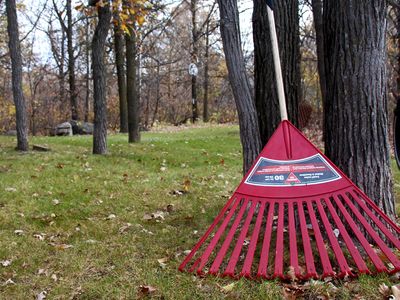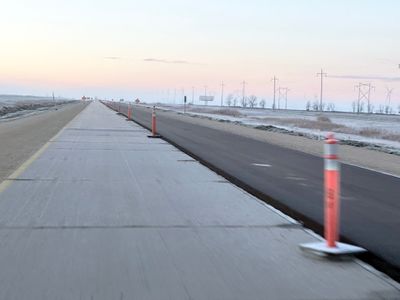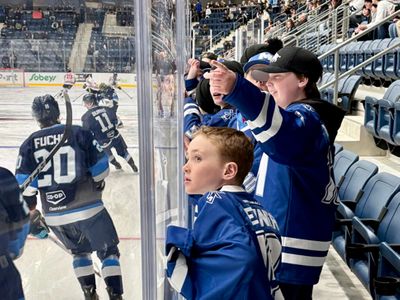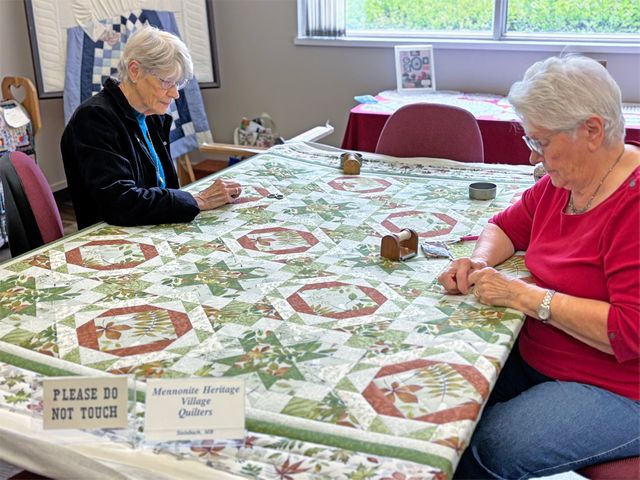Local News
Historic quilts tell stories of love and tradition at Mennonite Heritage Village
A Cozy Room Full of History As the weather cools and the days grow shorter, the quilting room at the Mennonite Heritage Village Museum (MHV) in Steinbach feels especially inviting. The warm hum of conversation, the quiet rhythm of needles, and the rows of colourful fabrics make it a cozy corner of local history, and one that holds layers of stories stitched together through generations. MHV Curator Garth Doerksen says the quilting room has become a favourite stop for visitors, especially this time of year. “Getting into winter, we’re looking at being warm and cozy,” he says. “Mostly quilts would have been made from fabric that would likely have been leftovers from other pieces of clothing and other items. They’d take patches or pieces out of those and combine them to make a quilt. So, it was a good use of fabrics that were likely not usable anymore.” In Mennonite communities, quilting was both a necessity and a social activity. It brought women together to share conversation, laughter, and sometimes even tears, while creating something practical that would keep families warm. Each quilt carried its own story, a mix of frugality, artistry, and love. A Wedding Quilt with Deep Roots Among the many pieces displayed in the room, one quilt stands out for its personal story and timeless beauty, a wedding quilt made in 1940 for Bernard and Katarina (Tina) Friesen, whose maiden name was Kroeker. “This is a wedding quilt, and it was made as a gift for the couple,” explains Doerksen. “The couple’s sisters, sisters-in-law, close friends, and their mothers each made a piece of this quilt. They embroidered a flower into a corner and then their names as well. The bride took those pieces and created a quilt out of it.” Each square of the quilt carries an individual’s touch; the delicate embroidery, graceful lettering, and colourful patterns were all stitched together to form a larger work of art and community. “Every woman had her own style,” Doerksen says. “The script isn’t identical, but it’s beautifully done. It would have been a wonderful memento for their wedding and a wonderful gift to receive.” Rediscovered and Displayed Although it was made more than 80 years ago, this quilt only recently found its way onto the wall of the MHV’s quilting room. “So, it was donated in 2021 and is now on display, because the quilt on that wall has been sold. The quilting ladies were asking if there was something else we could put up there, so I looked through our collection and found this one. We just put it up recently and added a label to share its history.” Once hung, the quilt immediately caught the attention of the quilting group that regularly gathers in the room. As they looked closely at the squares and names stitched into the fabric, conversations began to bubble up. Some recognized the names; others shared family connections. What’s in a Name? Doerksen says one of the details that stood out to the quilters was how the women identified themselves. “The names you see on the quilt would be like ‘Mrs. Aaron Reimer,’” he explains. “None of them are the women’s first names. That’s how they would have signed, as Mrs. and then their husband’s name.” That old-fashioned naming style says a lot about the era and the expectations of the time. “It really reflected the traditional views of marriage and family roles,” says Doerksen. “Of course, over the years, that’s changed, and thankfully now people would put their own first names on. There’s more individuality and recognition of the person herself.” Even with those formal signatures, the quilt sparked recognition and memories among today’s quilters. “You’d hear things like, ‘Oh, I know who Mrs. Aaron Friesen was!’” says Doerksen. “So it becomes more than just fabric and thread — it’s a connection between generations.” He adds that this quilt’s story didn’t end in Steinbach. “The couple married here in Canada, in Rosenort, but later moved to Mexico. They took the quilt with them, and when they returned, it came back too. So it’s done a little bit of traveling,” he says. “It’s incredible how far an artifact like that can go and still come back home.” The Grandmother Quilt — A Story in 3D Across the room, another quilt captures just as much attention, but in a very different way. Known around the museum as “the grandmother quilt,” this piece is part artwork, part illusion, and entirely storytelling. “It’s a picture of a grandmother who is quilting a quilt,” Doerksen explains. “But it’s three-dimensional, the quilt actually spills out of the quilt, so it becomes three-dimensional.” The subject of the artwork is Elizabeth K. Friesen, born in 1899, and the piece is based on a 1985 photograph of her sewing a quilt for her granddaughter, Beverly. The artist, Alvina Pankratz, recreated that moment using fabric, texture, and layered stitching to make it come alive. “It’s one of those wonderful moments of connection,” says Doerksen. “We were able to find out who the woman was thanks to one of our quilting ladies, Edna Klassen, who knew the family. I got in touch with Beverly Dueck, the granddaughter, and she confirmed that it was her grandmother. It’s really special to make that kind of connection, to tie a piece of art to the person who inspired it.” The quilt has become a visitor favourite, often prompting people to take a second look. “You really have to stop and look closely,” Doerksen says. “People ask, ‘Is it really 3D?’ And yes, it is. It’s such a unique feature.” Every Stitch Has a Story For Doerksen, quilts like these are much more than museum artifacts, they’re personal histories made tangible. “It’s the story behind the items that makes them most interesting,” he says. “Every piece here has a history, whether it’s a family connection, a moment in time, or a glimpse into what life was like back then.” That’s why he values donors who not only share their artifacts but also their stories. “When people donate, it’s so important to include the background,” he says. “That’s what helps us preserve the human side of history.” Museum Now Accepting Donations Again After a pause over the summer, the Mennonite Heritage Village has reopened its doors to new artifact donations. “We had a moratorium until October 1st, but that’s come and gone,” Doerksen says. “People can give me a call if they have something they’d like to donate. Sometimes they’ll send photos first, and we’ll see if it’s something unique or has a story attached to it.” He notes that while the museum already has a large collection, they’re always interested in items that help tell the story of Mennonite life and heritage, especially when those items have a personal connection to the region. “We do have a backlog still,” Doerksen admits, “but we’re always looking for artifacts that speak to the history of the people who lived here.” Threads That Connect Generations Back in the quilting room, the hum of conversation continues, much as it might have decades ago. The quilts that hang on the walls are more than decorations, they are storytellers, linking generations of Mennonite women and preserving traditions of creativity, family, and faith. As Doerksen looks around the room, he reflects on what makes these quilts special. “They’re beautiful, yes,” he says, “but it’s really the stories and the people behind them that make them come alive.” And as long as the quilting needles keep moving in the Mennonite Heritage Village, those stories, stitched carefully into fabric by loving hands, will continue to warm both the body and the heart for generations to come.









